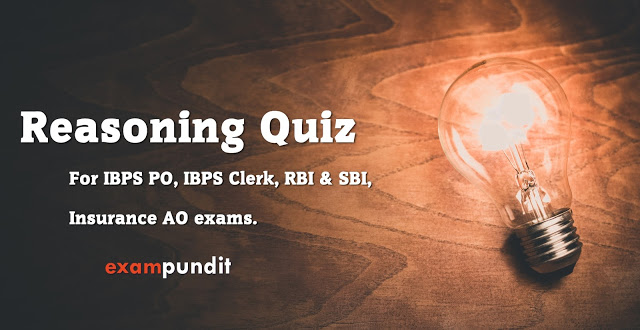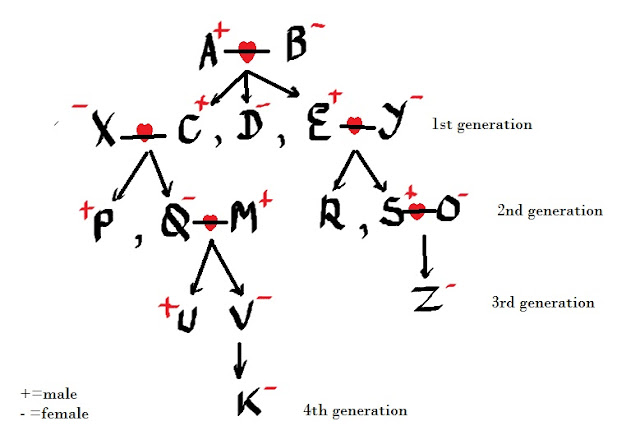Hello and welcome to exampundit. Here is a set of Reasoning Quiz for upcoming Bank and Insurance Exams. This quiz is specifically given for Syndicate PGDBF Exam.
Directions: Set of 5
questions – Read the following information and answer the questions(1-5)
carefully.
questions – Read the following information and answer the questions(1-5)
carefully.
Five friends –Sonali, Shaurya,
Subham, Siddharth, Somesh go to a garden and decide to play hide and seek.
Everyone uses different spots to hide during their turns except two who hide at
same spot. In the first turn. Subham started walking 2 metres east then took 4
metres to his right and then turned 5 metres to his left and found Siddharth
hiding in his spot. After Siddharth was caught, it was his turn to search for
others. He started from his hiding spot waked 4 meters to the west , then he
saw something in the bushes few distance away , thinking it to be one of his
friends, he turned left went 3 metres to the bush. From the bush he had to run
another 7 metres to the south and then turn left and walk 4 meters and caught
Sonali. In the next turn , Sonali starts from the bush at which Siddharth first
halted while finding her . She walked 2 metres to the west and then turned
right and walked 6 metres and after turning left she walked 5 metres and
caught Shaurya and Somesh.
Subham, Siddharth, Somesh go to a garden and decide to play hide and seek.
Everyone uses different spots to hide during their turns except two who hide at
same spot. In the first turn. Subham started walking 2 metres east then took 4
metres to his right and then turned 5 metres to his left and found Siddharth
hiding in his spot. After Siddharth was caught, it was his turn to search for
others. He started from his hiding spot waked 4 meters to the west , then he
saw something in the bushes few distance away , thinking it to be one of his
friends, he turned left went 3 metres to the bush. From the bush he had to run
another 7 metres to the south and then turn left and walk 4 meters and caught
Sonali. In the next turn , Sonali starts from the bush at which Siddharth first
halted while finding her . She walked 2 metres to the west and then turned
right and walked 6 metres and after turning left she walked 5 metres and
caught Shaurya and Somesh.
1. In which direction was Siddharth hiding from Subham’s
starting point?
starting point?
1) Southeast
2) Northeast
3) Southwest
4) South
5) None
2. What is the direction of Sonali ‘s starting point with respect to the hiding
spot of Siddharth ?
spot of Siddharth ?
1) Southwest
2) North
3) West
4) East
5) None
3. What is the direction of Subham’s starting point from the
bush?
bush?
1) West
2) Northeast
3) Southwest
4) Northwest
5) Southeast
4.Somesh is in which direction with respect to Sonali’s
hiding spot?
hiding spot?
1) Northwest
2) West
3) Southeast
4) East
5) None
5. What is the crowfly distance and direction of Sonali’s
hiding point from the bush?
hiding point from the bush?
1) √65 metres Southeast
2) √65 metres northeast
3) √63 metres north
4) 13 metres east
5) Cannot be determined
Directions: Set of 2
questions – Read the following information and answer the questions (6-7)
carefully.
questions – Read the following information and answer the questions (6-7)
carefully.
A is a retired army officer. He
has three children. His two sons – C and E have only 1 sister D. X and Y are
the sister-in-laws of D,E and C,D respectively. X and D have two children each.
The grandchildren of A and B are P,Q,R and S. P is the male sibling of Q. Q is
the cousin sister of R,S. S is the husband of O.O has only one daughter Z. U,V
are siblings( one male , one female). V is the cousin sister of Z. P and R are
unmarried.
has three children. His two sons – C and E have only 1 sister D. X and Y are
the sister-in-laws of D,E and C,D respectively. X and D have two children each.
The grandchildren of A and B are P,Q,R and S. P is the male sibling of Q. Q is
the cousin sister of R,S. S is the husband of O.O has only one daughter Z. U,V
are siblings( one male , one female). V is the cousin sister of Z. P and R are
unmarried.
6. If M is the father of V, how is he related to X?
1) son-in-law
2) son
3) great grandson-in-law
4) Cousin
5) Cannot be determined.
7. If V grows up and gets married and has a baby girl K,
then K will belong to which generation of
the family starting from A?
then K will belong to which generation of
the family starting from A?
1) Third
2) Fifth
3) Fourth
4) Second
5) None
Directions: Set of 5
questions – Read the following information and answer the questions(8-12)
carefully.
questions – Read the following information and answer the questions(8-12)
carefully.
In the following questions the symbols #, *, @. $ and = are
used with the following meanings:
used with the following meanings:
X # Y means X is greater than Y.
X * Y means X is greater than or equal to Y.
X @ Y means X is equal to Y.
X $ Y means X is lesser than Y.
X= Y means X is lesser than or equal to Y.
Give answer.
1) if only conclusion I is true
2) if only conclusion II is true
3) if either conclusion I or conclusion II is true
4) if neither conclusion I nor conclusion II is true
5) if both conclusions I and II are true.
8. Statements: A
# B, C $ A, C * O
# B, C $ A, C * O
Conclusions:
1. B # C
2. B $ C
9. Statements: A
= B, D @ C, C # A
= B, D @ C, C # A
Conclusions:
1. D = B
2. B *D
10. Statements: A
@ B, L @ M, A # L
@ B, L @ M, A # L
Conclusions:
1. B # M
2. M $ A
11. Statements: A
# M # L, L# N @ B, B $ S @ C
# M # L, L# N @ B, B $ S @ C
Conclusions:
1. C @ M
2. L @ C
12. Statements: A
* B, B@ D, D * L
* B, B@ D, D * L
Conclusions:
1. B # L
2. D # A
Answers:
- Ans-1
- Ans-1
- Ans-4
- Ans-1
- Ans-1
- Ans-1
- Ans-3
- Ans-4
- Ans-4
- Ans-5
- Ans-4
- Ans-4
Detailed Solutions:
1-5:
6-7:
8-12:
8. A>B
C<A C≥O
C<A C≥O
O≤C< A>B
9. A≤B D=C C>A
D=C>A≤B
10. A=B L=M A>L
B=A>L=M
11. A>M >L
>N=B<S=C
>N=B<S=C
12. A≥B=D≥L

Sponsored
(adsbygoogle = window.adsbygoogle || []).push({});
Regards
Team ExamPundit





